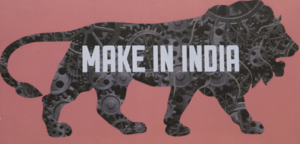Invent in India
It needs to complement Make in India. A drastic overhaul of science institutions will be necessary
Relevance
- GS Paper 3 Infrastructure: Energy, Ports, Roads, Airports, Railways etc.
- Investment models.
- Tags: #makeinindia #inventinindia #inovation #India #currentaffairs #upsc.
Why in the News?
Putin praises India’s Make in India program at 8th Eastern Economic Forum.
- India’s rapid economic growth has propelled it to the position of the world’s fifth-largest economy, with projections pointing towards a climb to the third spot. Despite these achievements, India faces significant challenges in the domains of innovation, science, and technology. The primary contributing factor to this challenge is the underutilization of Indian academia and industry in national research and development (R&D) efforts.
- While recent policy corrections have been made, including the “Make in India” initiative, there is a growing recognition that “Invent in India” must complement this endeavor. This article explores the essential reforms needed to rejuvenate India’s scientific institutions and ensure they power the nation’s journey towards a $10 trillion economy.
The Need for an Overhaul
Current Challenges in Innovation and Technology
- India’s progress in innovation, science, and technology lags behind its economic growth. Several factors, including constraints in land, labor, capital markets, and trade policies, have hindered innovation and R&D in key sectors. Although corrective measures have been taken, challenges persist.
Recognizing the Role of Patents
- In tandem with “Make in India,” the government acknowledges the importance of patents and is working to streamline the patenting process.
- Bilateral agreements, especially with the United States, highlight the strategic importance of innovation and the need for “Invent in India” to complement “Make in India.”
Revamping Scientific Institutions
The Role of the National Research Foundation (NRF)
- The newly established NRF holds promise in addressing the challenges of “Invent in India.” However, to effectively drive scientific knowledge into technology-based wealth, a comprehensive overhaul of institutions is necessary.
Three Critical Parameters for Institutional Reform
Prioritizing Merit and Quality
- Merit and quality in human capital should be paramount. Academic and research institutions should align their objectives more closely with industry needs.
- Encouraging collaboration between innovative scientists and industry for additional funding is crucial for high-risk, high-reward research.
Bringing Teaching and Research Together
- Historically, there has been a separation between teaching and research in India’s academic institutions. Reforms should aim to merge these domains, fostering a merit-driven group admissions system. This change will encourage a more research-oriented approach.
Barbell Strategy for Research Funding
- India should adopt a funding strategy with high convexity. High-risk, high-payoff projects should receive funding from a consortium of government agencies and industry partners.
- This approach has proven successful in initiatives like the New Millennium India Technology Leadership Initiative (NMITLI) and the Design-Linked Incentive (DLI)
Cultivating a New Culture
Incentivizing Collegiality and Controlled Risk-Taking
- Beyond institutional and hardware changes, India’s scientific culture requires a transformation. Incentives should be aligned to foster collegiality, eliminate hierarchical mindsets, curb cartelization, and encourage controlled risk-taking. Long-term performance depends on the quality and motivation of individuals in the scientific community.
Retaining and Attracting Talent
- India must retain its premier talent and attract talent from abroad. A shift from the remittance-seeking mindset of the past to a focus on value creation is essential. Encouraging industry involvement through profit incentives and competitive pressure can help achieve this goal.
Scientific culture
- Cultivating a new scientific culture that incentivizes collegiality and risk-taking while retaining and attracting talent is equally vital. These reforms are not only essential for India’s economic progress but also for national security. As we navigate this critical phase, it is imperative that we prioritize and invest in our scientific future.
Conclusion
“Invent in India” must complement “Make in India” to propel India’s economic growth to new heights. Achieving this requires a significant overhaul of scientific institutions, emphasizing merit and quality, bridging the gap between teaching and research, and adopting a barbell funding strategy.
| Key Schemes Supporting Make In India
1. Skill India Mission: Aims to annually skill 10 million people across various sectors to enhance the skilled workforce. 2. Startup India: Fosters a startup-friendly ecosystem with relaxations for entrepreneurs, promoting economic growth and employment. 3. Digital India: Transforms India into a digitally empowered economy with online services. 4. Pradhan Mantri Jan Dhan Yojana (PMJDY): Ensures financial inclusion through affordable access to banking, savings, remittances, credit, insurance, and pensions. 5. Smart Cities: Aims to rejuvenate Indian cities and create 100 smart cities through various initiatives. 6. AMRUT: Atal Mission for Rejuvenation and Urban Transformation focuses on building public amenities and improving 500 cities’ livability. 7. Swachh Bharat Abhiyan: Promotes sanitation, hygiene, and cleanliness in India. 8. Sagarmala: Develops ports and fosters port-led development, including construction and renovation of ports. 9. AGNII: Accelerates innovation in India by connecting people and facilitating innovation commercialization. |
Sources: Indian Express
Mains Question
“Discuss the role of ‘Invent in India’ in complementing the ‘Make in India’ initiative and its significance for India’s economic growth. Examine the challenges faced by Indian academia and industry in contributing to national R&D efforts” 250words.




